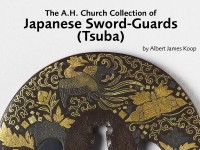The A. H. Church Collection of Japanese Sword-Guards (Tsuba)
An unpublished catalogue of the A. H. Church collection of Japanese sword-guards (tsuba) by Albert James Koop.

The founder of this school, Yokoya Motonori (first half of the 18th century), was a pupil of the Yokoya and worked entirely in their manner. His successor Ōyama Motozane I (Taizan, Sekijōken; b. 1739, d. 1829) established the characteristic Sekijōken style and was followed by more than twenty direct pupils, while numerous other workers perpetuated the style down to the last quarter of the 19th century.
The iron or soft metal grounds, of beautiful colour and finish, treated with soft modelling and delicate iroye incrustation of gold, silver, copper or shakudō, recall in the part the work of the Jōi group, the animation of the pictorial subjects that of the Nara generally.
 Tsuba with grape vine (EAX.11009)
Tsuba with grape vine (EAX.11009)
 Tsuba depicting the Three Sake Tasters around a wine jar (EAX.11010)
Tsuba depicting the Three Sake Tasters around a wine jar (EAX.11010)
 Tsuba with dragon and clouds (EAX.11011)
Tsuba with dragon and clouds (EAX.11011)
Notice
Object information may not accurately reflect the actual contents of the original publication, since our online objects contain current information held in our collections database. Click on 'buy this publication' to purchase printed versions of our online publications, where available, or contact the Jameel Study Centre to arrange access to books on our collections that are now out of print.
© 2013 University of Oxford - Ashmolean Museum





